
| Palaeos |  |
Dinocaridida |
| Ecdysozoa | Anomalocarididae |
| Page Back: Opabinia | Unit Up: Ecdysozoa | Unit Home | Clade Up: Panarthropoda | Page Next: Anomalocarididae (2) |
| Unit Back: Onychophora | Clade Down: Arthropoda | Dendrogram | References | Unit Next: Arthropoda |
|
Abbreviated Dendrogram
PANARTHROPODA `==Siberiidae | `--DINOCARIDIDA |--Kerygmachela `--+--Pambdelurion `--+--Opabinia `--+--Anomalocarididae | |?--Amplectobelua | |--Hurdia | `--+--Anomalocaris | `--Laggania `--+--Schinderhannes `--ARTHROPODA |
Contents
Overview |
from Wikipedia, GNU Free Documentation/Creative Commons Attribution Share Alike |
The largest and most impressive animals of the Cambrian and Early Ordovician periods, the Anomalocaridids represent the culmination of dinocaridid evolution (although not the msot lasting legacy; that honour would go to their somewhat smaller descendants the early arthropods).
The earliest known Anomalocaridid to date is Cassubia infercambriensis, from the earliest Cambrian of Poland, predating the first trilobites (Dzik & Lendzion 1988). Anomalocaridids, like Dinocaridids in general, are best known from the mid Early Cambrian through to the mid Middle Cambrian. Their rarity as fossils thereafter is due to their non-mineralised (soft-bodied) cuticle and the the scarcity of post- Midlde Cambrian lagerstatten. It is now known that large bodied anomalocaridids continued well into the early Ordovcian at least (Van Roy & Briggs 2011).
In life anomalocaridids would have been easily recognisable (see image above) as large segmented, swimming arthropod-like animals with a distinctive pair of raptorial appendages under the head, huge compound eyes (Anomalocaris had extremely acute vision even by contemporary standards (Paterson et al 2011)), and pairs of swimming lobes along the trunk. The mouth is a circular or rectangular structure resembling a pineapple slice, consisting of a ring of hard sharp teeth in the central orifice. The teeth did not meet in the middle, which led to the hypothesis, which we reject, that anomalocaridids were harmless plankton feeders (Hagadorn, 2009) . In Hurdia at least, there were further rows of teeth behind the first (a bit like the creature from Alien perhaps), while Anomalocaris itself would have used a different killing stratergy, using its powerful arms to grab and shake a trilobite to pieces (Nedin, 1999).
Being soft bodied ( they did not have a heavy exoskeleton like trilobites), they would have quickly disintegrate after death. The hard parts most easily preserved are the pineapple-ring mouth and the grasping arms. Not surprisingly, when the fossils were originally discovered, in the first decades of thr 20th century, each part of the animal was found in isolation and thought to belong a different phylum. The arms were considered an arthropod, (Anomalocaris), the mouth interpreted as a jellyfish (Peytoia), and the body, which appeared as a mostly shapeless blob, was interpreted as a sponge (Laggania) or an echinoderm (Hurdia). It was only in trhe 1980s (Whittington & Briggs 1985) that it was realised that all these different elements were part of a single animal, larger than any other Cambrian animal. This was named Anomalocaris because these were the first of the various part-names rto be coined (in the case of plant fossils there is a simliar problem, when the seeds, bark, leaves., stem, roots, etc are each given different names)
When Stephen Jay Gould first popularised this creature in his book Wonderful Life, and for some years afterwards, it was not known what phylum of organisms Anomalocaris belonged to. It was frequently lumped with arthropods on the basis of its jointed body; however, other creatures like annelids have also evolved a segmented body). An alternative explanation was that it was a kind of aschelminth (pseudocoelomate worm), as indicated for example by its asymmetrical mouth. Without doubt it is among the "molting animals" ( a group that includes many segmented animals). Its difference from modern organisms was considered a reminder, as are all the problematica, of the diversity of life, and the fact that the type of creatures around at present are only a fraction of the number and diversity that have ever lived.
Thanks to cladistic analysis and new fossil discoveries we know a lot more about Anomalocaris than we did in the 1980s. We know now for example that it is a transitional form between lobopods and true arthropods, although whether it is classed as a lobopod or an arthropod depends on where you draw the line. Despite arguments by Hou & Bergstrom (e.g. 2006) it is no longer considered a giant aschelminth worm, or anything as alien as Gould imagined. In fact the aschelminth attributes are simply inherited primitive features (plesiomorphies) possessed by ancestral ecdysozoa. The current consensus is that Anomalocaris is an arthropod whereas its more primitive cousin Kerygmachela is a lobopod. This despite there probably more similarities between Anomalocaris and Kerygmachela than between Kerygmachela and typical lobopods, or between Anomalocaris and true arthropods.
Today, at least four genera of anomalocarids are known: Anomalocaris, Hurdia, Laggania, and Amplectobelua. Similar and clearly related animals include Kerygmachela,, Parapeytoia, Pambdelurion and Schinderhannes. These probably belong to different families, although they would all seem to be part of the same evolutionary gradation. MAK990601, Wikipedia, MAK120511
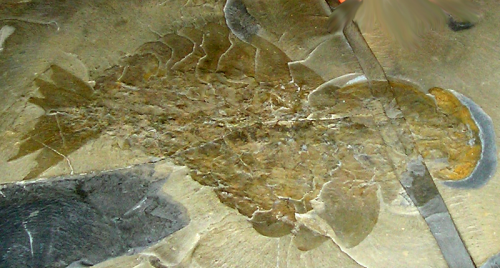 The first complete Anomalocaris fossil found, Royal Ontario Museum, Toronto.
The first complete Anomalocaris fossil found, Royal Ontario Museum, Toronto.Photo by Keith Schengili-Roberts, via Wikipedia, GNU Free Documentation/Creative Commons Attribution Share Alike |
Anomalocarididae Raymond 1935
Range: Early Cambr- early Ord, Cosm.
Phylogeny: Dinocaridida : Kerygmachela + (Pambdelurion + (Opabinia + ((Schinderhannes + (Parapeytoia + Arthropoda)) + * : + Amplectobelua + Hurdia + (Anomalocaris + Laggania))))
Characters: Trunk walking legs either absent or if present not sclerotised (Hou & Bergström (2006)); large size (20 to 100 cm) . With Arthropoda: Hypostome; arthropodization of appendages (Daley et al. 2009) ; very large (~16,000 lenses) compound eyes consistent with a lifestyle of midwater predators in the photic zone (Paterson et al 2011)6.
Comments: The following is from Minicucci (1999), via the Peripatus website, and is included because it gives a comprehensive tabulation of anomalocarid species. As this material was written more than a dozen years ago it is obvious in need of revision and updating MAK120509
"In accordance with the criteria established by Collins (1996), all anomalocarids may be diagnosed as being bilaterally symmetrical, with two distinct tagmata, but other features, such as lateral lobes, grasping appendages, biramous appendages, form of the trunk, and anterior tagmata vary between types of genera.
"Based only on the current descriptions of anomalocarids, and a casual observation of the available evidence, I have listed several groups possibly comprising distinct grades of anomalocarid body organization. The inadequately described Chen and Zhou arthropod (1997), if it is truly an anomalocarid, could very well represent an ancestral grade of anomalocarid body organization unknown in other described forms. Groups 1, 2 and 3 comprise a grade of genera possessing a soft cuticle, simple body organization, and uniramous trunk appendages. Group 4 contains the grade of genera with complex degrees of tagmosis and sclerotization, and biramous trunk appendages, while group 5 represents the grade of genera that have made a radical departure from the body designs of the other grades. A thorough cladistic analysis incorporating all described and undescribed taxa will ultimately determine the viability of this concept" .
| Character | Group 1 | Group 2 | Group 3 | Group 4 | Group 5 |
| Mouthparts & grasping appendages | sclerotised | sclerotised | sclerotised | sclerotised; mouthparts facing backwards | anterior tagmata formed of several carapace-like components bearing two sheathed claws on stalks. Below the carapaces, the jaws have an inner set of teeth, and are surrounded by pair of claws |
| Sclerotisation of body | ‘naked’ | ‘naked’ | significantly sclerotized body including median sternites | ||
| Body ornament | smooth-surfaced; no ornamentation or raised features of any kind | smooth-surfaced; equivocal evidence of striations on the entire ventral surface of lateral lobes | diagonal striations on the lateral lobes (interpreted as veins by some authors); two exasaggital ventral rows of serially-repeated, nodular structures | ?dorsal lanceolate scales; diagonal striations are present on lateral lobes | |
| Trunk annulation/external segmentation | no visible annulation or segmentation | no visible annulation or segmentation | no confirmed trunk annulation or external segmentation | trunk has 11 segments and a tail | |
| External gill-like structures | none apparent | none apparent | |||
| Lateral lobes | 13 pairs | 14 pairs, with support ‘rods’ present | setae-like structures present on lateral lobes | ||
| Jointed trunk appendages | none | none | none | gnathobasic biramous trunk appendages, grasping appendages | gnathobasic, biramous trunk appendages |
| ‘Tail’ | posterodorsal finlets arranged en echelon | tapers to blunt extremity | tail furcae present; posterodorsal ‘tail’ finlets arranged en echelon | ||
| Example(s) | Anomalocaris canadensis | Laggania cambria | Anomalocaris saron, Amplectobelua symbrachiata | Parapeytoia yunnanensis, Cucumericrus decoratus | Hurdia sp., (jnr syn: Proboscicaris sp.) |
| References | Collins 1996 | Collins 1996 | Chen et al. 1994; Hou et al. 1995 | Hou et al. 1995; other forms awaiting description by Ramsköld (1995) could fall into this group | Collins 1992, 1996 |
| Table 1: Minicucci’s (1999) five ‘grades’ of anomalocarid organisation. | |||||
"The reported morphological variations present in assorted anomalocarid genera emphatically illustrate the former diversity of these animals. Indeed, preliminary descriptions of very unusual genera with several frontal carapace-like components forming the anterior tagmata (Collins 1992, 1996), and reports of more genera with gnathobasic, biramous appendages (Ramsköld 1995) indicate that anomalocarids evolved an assortment of specialized forms, and varying degrees of tagmosis and sclerotization, perhaps enabling them to occupy different feeding guilds. At this juncture, virtually no substantive information has been published on such forms. It appears that all described and even undescribed genera may be sorted according to several distinct grades of anomalocarid body organization. Superficially identifiable are the genera with a soft-cuticle or minimal sclerotization, possessing uniramous trunk appendages (lateral lobes only); the genera with complex degrees of tagmosis and sclerotization, possessing biramous trunk appendages; and the Hurdia-type genera, which radically depart from the two former body designs (see Collins 1992). Assigning the different grades taxonomic rankings, either by assigning each to sub-familial status within the Anomalocaridae, or by erecting family level taxa for each within an Order, depends on how each grade could be proven to be distinct cladistically. More grades of body organization must surely have existed, and are as yet unrepresented or unrecognized in fossil collections. It is, of course, possible that the same type of body organization expressed among similar genera could merely reflect homoplasy in anomalocarids not closely related" (Minicucci 1999). - url.)
Recent cladistic analysis by Daley et al. 2009 has Hurdia as a more distinct taxon (no doyubt due to its unusual characteristics such as the larger head shield and multiple tooth rows), with Anomalocaris + Laggania as the crown group. Anomalocaris is also considered the most advanced (derived) taxon. Amplectobelua and Parapeytoia were not included so their position in the Anomalocaridid family tree remains unknown. We tentatively consider Parapeytoia a transitional anomalocarid-arthropod on the basis of its equally being able to be included with either group. It may be however that Parapeytoia may turn out to be a more convemntional "great appendage" arthropod. From the above table, perhaps Anomalocaris saron is better placed under the genus Amplectobelua. For now however we have retained it under Anomalocaris. MAK120512
Amplectobelua Hou, Bergström & Ahlberg, 1995 : A. symbrachiata Hou, Bergström & Ahlberg, 1995 A. stephenensis Daley & Budd, 2010
Range: Early to Middle Cambrian (Chengjiang and Burgess Shale)
Phylogeny: Anomalocarididae : Hurdia + (Anomalocaris + Laggania) + *
Comments: known from two species, Amplectobelua was smaller and more compact, with wider body, than other anomalocarids. Large eyes positioned laterally (to the side of) of the mouth. The grasping appendages have pairs of spine-like endites generally devoid of 'auxiliary' spines, and several extended lobes on both sides, the endite near proximal end stout and exceptionally long, one-third to nearly half as long as the length of the appendage.. It had a pair long, feeler-like cerci that extended from the posterior end of the body. Daley & Budd 2010, Wikipedia. MAK120507
Links: Amplectobelua symbrachiata by Sam Gon III
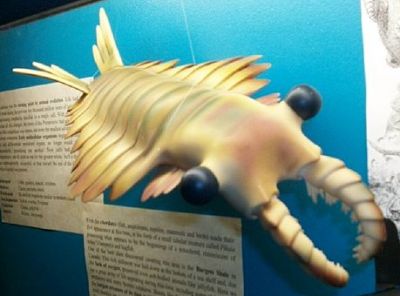
Anomalocaris Whiteaves 1892 : A. canadensis Whiteaves 1892 (Burgess Shale, type species) ; A. saron Hou, Bergström & Ahlberg 1995 (Chengjiang); A. briggsi Nedin 1995 (Emu Bay Shale, South Australia, photo)
Range: Early to Middle Cambrian, Chengjiang, Burgess Shale, and Emu Bay Shale Lagerstätten, Greenland (Briggs et al. 1994, pp. 201-202. and Nevada (Lieberman, 2003))
Phylogeny: Anomalocarididae : Amplectobelua + Hurdia + (Laggania + * )
Characters: Spinose robust great appendage with 15 articles and a double row of spines; posterior tagma composed of three paired tail flaps; with Laggania: Posterior tapering of lateral lobes. Daley et al. 2009)
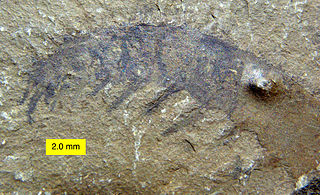
Comments: The archetypal dinocaridid, first discovered by Joseph Frederick Whiteaves, who described Anomalocaris canadensis from the Ogygopsis Shale on Mount Stephen (actually the grasping forelimbs); Walcott found similar limbs in the Burgess Shale, together with those of A. nathorsti (= Laggania cambria). Walcott also discovered the circlets of plates, that he named Peytoia and interpreted as a medusoid, which are now known to be anomalocaridid mouthparts (however as the mouthparts of Anomalocaris itself are in not tetraradial like 'Peytoia', but have three major axes and a small central opening). The name Anomalocaris (meaning "strange shrimp") originally referred to the detached arms; these were believed to the be the body of a Crustacean-like animal for which always seemed to be found minus the head. (left)
Harry Whittington and Derek Briggs recognised that these were different parts of the same animal, which they described in 1985 (Whittington & Briggs 1985). Gould's Wonderful Life, published only a couple of years later, brought the animal to the public eye, but also confused several species. It is now known that these various anomalacarii belong to at least four related genera, although all can be included in the same family. Simon Conway's The Crucible of Creation written about a decade after Gould's work, also features Anomalocaris, and it has featured in popular science documentaries in the following years and decade 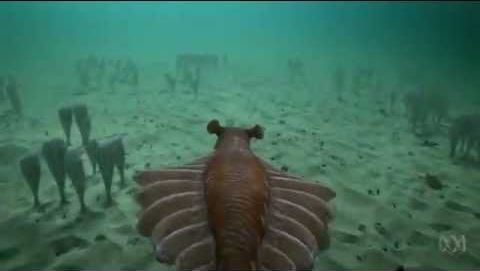 (Walking with Monsters (2005), David Attenborough's First Life (2010), and Australia: The Time Traveller's Guide (2012) - see still at right. It is unfortunate (if understandable given the need to impress a non-technical audience) that such useful eduactional series, with their impressive special effects, should give in to a tendency to exagerration, with the 50 to 60 cm original animal now uniformly reaching 2 meters in length [1], a three to four-fold increase in linear dimensions (a better known instance of this is the 25 meter Liopleurodon of Walking with Dinosaurs; however the case for a two meter anomalocaridid is a lot stronger than for a 25 meter pliosaur)
(Walking with Monsters (2005), David Attenborough's First Life (2010), and Australia: The Time Traveller's Guide (2012) - see still at right. It is unfortunate (if understandable given the need to impress a non-technical audience) that such useful eduactional series, with their impressive special effects, should give in to a tendency to exagerration, with the 50 to 60 cm original animal now uniformly reaching 2 meters in length [1], a three to four-fold increase in linear dimensions (a better known instance of this is the 25 meter Liopleurodon of Walking with Dinosaurs; however the case for a two meter anomalocaridid is a lot stronger than for a 25 meter pliosaur)
Anomalocaris had very developed vision and it and its close relatives were among the most primitive animals to evolve compound eyes. The exceptionally large eyes indicate that anomalocaridids were visually-based midwater predators in the photic zone (Paterson et al 2011)
Since Anomalocaris lacks any mineralised tissue, it seemed unlikely that it would be able to penetrate the hard, calcified shell of trilobites. One possibility is that anomalocarids fed by grabbing one end of their prey in their jaws while using their appendages to quickly rock the other end of the animal back and forth. This produced stresses that exploited the weaknesses of arthropod cuticle, causing the prey's exoskeleton to rupture and allowing the predator to access its innards. This behaviour is thought to have provided an evolutionary pressure for trilobites to roll up, to avoid being flexed until they snapped (Nedin, 1999) - Wikipedia. Although Anomalocaris did not seem to have the inner tooth rows of Hurdia Daley et al. 2009 and hence was unable to close its mouth, it would certainly have used its circular outer teeth for other purposes, perhaps to break open the weakened trilobite carapace.<./p>
A number of species of this cosmopolitan animal are now known. The best known are the original A. canadensis from the Middle Cambrian Burgess Shale, and A. saron, a somewhat earluier form from the Earky Cambrian of Chengjiang, China. Anomalocaris briggsi is a very large Gondwanan species, also Early Cambrian, from South Australia. Two additional species have been reported from the Early-Middle Cambrian boundary in the Comet Shale Member of the Pioche Formation in Nevada (Lieberman, 2003). Anomalocaris briggsi, Anomalocaris pennsylvanica (incl. cf. pennsylvanica), Anomalocaris sp. and the ‘appendage F’ anomalocarid are indeterminate forms based on grasping appendages only (Minicucci 1999). The largest known Anomalocarid, either a genus of Anomalocaris itself or a related form, is a meter long giant from the Early Ordovican Fezouata Biota of southeastern Morocco (Van Roy & Briggs 2011) MAK120509
Notes: [1] The two meter claim derives from extrapolation based on remains of peyotia mouthparts from the early Cambrian Chengjiang biota of China, but these estimates are uncertain Hou et al 2006, cited in Van Roy & Briggs 2011)
Links: Anomalocaris canadensis and Anomalocaris saron by Sam Gon III; Smithsonian; Wikipedia, Art Evolved (Anomalocaridids) MAK120509
Images: Upper right, Anomalocaris model at Dinosaur Museum, Canberra, Australia. Photo by Photnart, Public Domain; Above left, Anomalocaris grasping limb from the Mt. Stephen Trilobite Beds, Middle Cambrian, near Field, British Columbia, Canada. Photograph by Mark A. Wilson, Department of Geology, The College of Wooster, Public domain, via Wikipedia; Above right Anomalocaris hunting, a still from Australia: The Time Traveller's Guide, © ABC
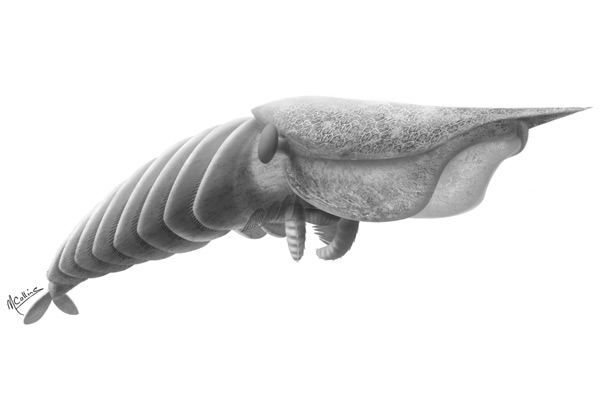
Hurdia Hurdia victoria Walcott 1912, and Hurdia spp.
Synonyms: Amiella ornata/Sidneyia ornata, Anomalocaris nathorsti, Liantuoia inflata, Huangshandongia yichangensis, Proboscicaris spp. Some specimens attributed to Emeraldella brocki. and Sidneyia inexpectans are actually Hurdia victoria. (Daley et al. 2009)
Range: Early to Middle Cambrian; known from six Burgess Shale localities in the Canadian Rockies (mid Middle Cambrian), as well as in the Marjum Formation of Utah (slightly later Middle Cambrian), also the Middle Cambroian of Bohemia (Proboscicaris hospes), and possibly Nevada, and China (Liantuoia inflata and Huangshandongia yichangensis from the Early Cambrian Shuijingtuo Formation in Huangshandong, Yichang, West Hubei; originally considered Crustacean carapaces) .
Phylogeny: Anomalocarididae : Amplectobelua + (Anomalocaris + Laggania) + *
Characters: Extra teeth rows within central mouth part opening; poorly defined, non-tapering lateral lobes - Daley et al. 2009
Comments: First described from fragmentary fossils by American paleontologist Charles Walcott in 1909, (Probably named for Mount Hurd nearby, itself commemorating Major Hurd, a Canadian Pacific Railway engineer and explorer.) while cataloging the Burgess Shale. However he mistakenly thought that the various body parts belonged to different creatures, which led to them being misclassified variously as a species of jellyfish, sea cucumber and its close relative Anomalocaris. In the late 1990s, then-curator of the Royal Ontario Museum Desmond H. Collins connected the elements of the Hurdia animal, presenting his ideas in informal articles, (Collins 1992, 1999) but it was not until 2009, after three years of painstaking research, that the complete organism was reconstructed. (Daley et al. 2009)
Hurdia possesses a general body architecture similar to those of Anomalocaris and Laggania, including the presence of exceptionally well-preserved gills, but differs by possessing a prominent anterior carapace structure. The function of this organ remains mysterious; it cannot have been protective as there appears to have been no underlying soft tissue. As with other dinocaridids, lateral lobes ran along the sides of the organisms, from which large gills were suspended. Daley et al. 2009, Wikipedia)
The mouthparts consist of an outer radial arrangement of 32 broadly elliptical plates, as in Laggania and Anomalocaris, which make up a domed structure. Within the central opening are upto five inner rows of teeth Daley et al. 2009 argue that these are lacking in Laggania and Anomalocaris. There is an inconsistency here by the fact that Hurdia has less robust grasping appendages than Anomalocaris, It may be however that Hurdia bit down on medium-sized prey, whereas Anomalocaris fed on larger and more heavily armoured animals like trilobites but bending and tearing them apart (Nedin, 1999) MAK120511
Hurdia was one of the largest organisms in the Cambrian oceans, reaching approximately 50 cm in length. -Wikipedia It displayed a cosmopolitan distribution; it has been recovered from the Burgess shale as well as sites in the USA, China and Europe. It's wide distribution suggests that Hurdia was a generalist adapted to a range of environmental conditions (Daley et al. 2009)
Regarding the list of synonyms given above, given the temporal and geographic range, and contra Daley et al. 2009 we do not believe ithey all belong tot the same species, although it is quite reasonable to assume they would belong to the same genus. This implies there were a number of distinct parallel evolutionary lineages of anomalocaridids existing side by side during the Cambreian, each specialising in specific lifestyles.. MAK120511
69 specimens of Hurdia are known from the Greater Phyllopod bed, where they comprise 0.13% of the community (Caron & Jackson 2006), although some of the specimens identified with other species may belong; according to Daley et al. (2009), Hurdia is the most common anomalocaridid in at least the Walcott Quarry.
Image: Life reconstruction by Marianne Collins, from Daley et al. 2009 , © ;Science AAAS
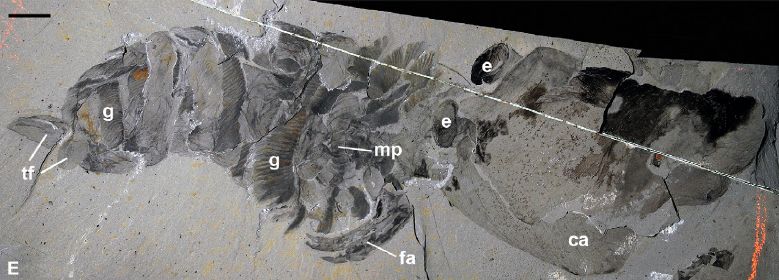 |
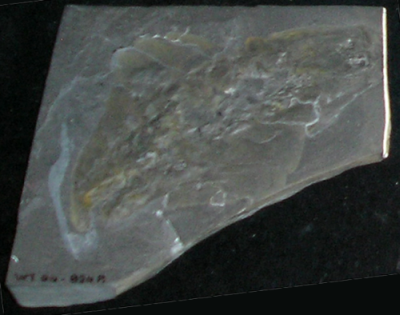
Laggania cambria Walcott 1911
Synonym: Peytoia nathorsti Walcott 1911, Anomalocaris nathorsti
Horizon: Burgess Shale
Phylogeny: Anomalocarididae : Amplectobelua + Hurdia + (Anomalocaris + *)
Comments: Originally described by Charles Walcott in 1911 as a holothurian echinoderm (Durham 1974). Compared with Anomalocaris species, Laggania species lacked tail structures and had a considerably larger head with the eyes placed behind instead of in front of the mouth, which would have been disadvantagous for active hunting. Because of these characteristics, some scientists have described Laggania as a cruising, plankton feeder (Dzik & Lendzion 1988). Alternatively, it may simply have had a different hunting and feeding strategy. We have already expressed our opinion on the planktonic anomalocarid hypothesis elsewhere. The co-existence of so many types of anomalocarids in the same localities points to a diversity of guilds. 108 specimens of Laggania are known from the Greater Phyllopod bed, where they comprise 0.21% of the community. (Caron & Jackson 2006), Wikipedia, although some of these specimens may belong to Hurdia MAK120507
Links: Laggania cambria by Sam Gon III; "Laggania cambria". Burgess Shale Fossil Gallery. Virtual Museum of Canada. 2011. Image: Laggania cambria from the Burgess Shale, fossil in the Royal Ontario Museum, Toronto. Photo by Keith Schengili-Roberts, via Wikimedia, GNU Free Documentation/Creative Commons Attribution Share Alike. See top of page for how this animal would have appeared in life. MAK120509
| Page Back | Unit Home | Page Top | Page Next |
page MAK120511; all text by MAK is Creative Commons Attribution